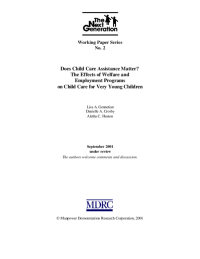Does Child Care Assistance Matter?
The Effects of Welfare and Employment Programs on Child Care
Summary of Key Findings from Working Paper Nos. 1-3
Families’ decisions about child care depend on many factors, including ability to pay for care, work schedules, and the local supply of care. Low-income parents often opt for informal (home-based) care because of its flexibility and low cost. Formal (center-based) care, however, has the advantage of being generally more stable and reliable, though also more expensive. Child care policies have the potential both to support parents’ employment and to foster children’s development. How does the child care assistance offered through welfare and employment programs affect poor families’ child care decisions?
The three papers from the Next Generation project summarized here address this critical question using survey data collected in studies of 21 programs for low-income single parents; all the studies used a design in which each parent was randomly assigned to a program or a control group. The programs, which operated between the late 1980s and the mid 1990s, implemented different combinations of policies, including requiring parents to participate in work-related activities (to raise employment and earnings), supplementing parents’ earnings (to increase family resources), and helping parents find and pay for formal child care. To make child care more affordable and accessible, seven of the programs offered more generous child care subsidies or case management support; three of the seven also provided greater access to information about formal care arrangements.
The effects of these expanded child care policies are synthesized by comparing outcomes in the programs that included the policies with those in the 14 programs that offered standard child care assistance to both program and control group members. Child care use is analyzed over a two-year period at the beginning of which children fell into three different age groups: very young (0 to 2 years), preschool-aged (3 to 5 years), and young school-aged (6 to 9 years). The type of analysis presented in these papers allows the effects of child care policies on families’ economic, child care, and other outcomes to be disentangled from those of other program components with which child care policies are often combined (such as participation mandates, earnings supplements, and time limits on welfare receipt).
Key Findings
- The expansions of child care assistance provided by the programs varied in specificity. Some programs offered more generous assistance for any paid care; some provided more generous assistance only for licensed care (formal or informal); and some offered subsidies or services specifically aimed at increasing the use of formal care.
- Expanded child care assistance generally increased families’ use of formal care, even when the assistance was not earmarked for formal care. At the same time, a large proportion of program group families chose informal care for their very young and young school-aged children.
- Policies that were aimed at encouraging employment, such as earnings supplements and work requirements, typically increased the amount — but did not affect the type — of child care used.
- The programs’ effects on child care use were most pronounced for preschool-aged children, a group for whom a larger number of formal care options are available.
These findings suggest that, when child care is made more affordable and accessible, more low-income parents will choose formal care settings for their children. Some programs led more families to choose formal care by offering expanded subsidies that made it affordable, whereas others did so by implementing policies and practices explicitly designed to encourage the use of formal care. Upcoming papers from the Next Generation project will use ethnographic interview data to examine how low-income families make child care decisions and will compare the effectiveness of formal and informal care in supporting parents’ employment and improving children’s developmental outcomes.






